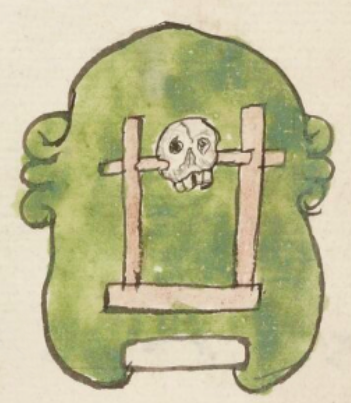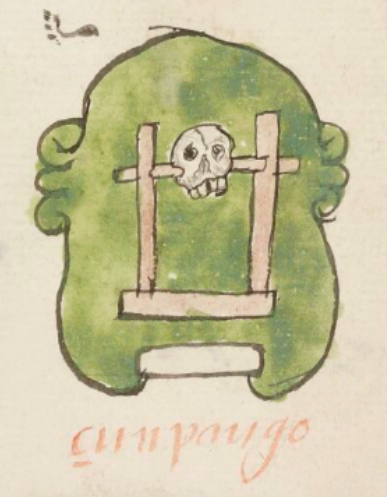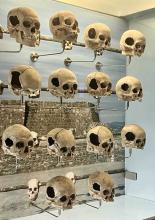Tzompanco (TR26r)
This compound sign for the place name Tzompanco shows a skull rack (tzompantli) in front of a hill or mountain. The latter seems to serve in place of a visual for the locative suffix (-co). The skull rack is a rectangular, wooden structure shown in a frontal view. It only has one skull, looking toward the viewer, on a cross bar. The bell-shaped hill is painted in a mottled green (but with no shading). It has curling rocky outcroppings on the slopes (but not at the top). The horizontal bar across the base is white (not red and yellow).
Stephanie Wood
The tepetl sign differs in various ways from the tepetl signs of the Codex Mendoza, such as in its more oval (less bell-like) shape, its more uniform coloring, and its details with regard to rockiness and the opening at the bottom. Also, here, its typical role as the locative "on the hill" (-tepec) is not employed, and it seems to hold an implied meaning for -co ("at").
Stephanie Wood
çunpango
Tzompanco
Stephanie Wood
ca. 1550–1563
Jeff Haskett-Wood and Stephanie Wood
skulls, cráneos, wood, madera, technology, tecnología, death, muerte, nombres de lugares
This reassemblage of a tzompantli that was discovered in an excavation in Tecoaque (formerly Zempoala or Cempohuallan), Tlaxcala, in 1993, shows how the skulls were perforated on the sides so that they could face forward, as seen in the glyph above. The fourteen skulls that comprise this shocking archaeological artifact include fourteen prisoners that were sacrificed by Acolhuas. Historical records mention the sacrifice of five Spaniards from the armed party of Juan de Yuste plus seven Indigenous cempohualtecas who were allied with the Spaniards. Museo Nacional de Historia, Chapultepec Park, Mexico City. Photo by S. Wood, 29 April 2025.

tzompan(tli), skull rack, https://nahuatl.wired-humanities.org/content/tzompantli
-co (locative suffix), says where, https://nahuatl.wired-humanities.org/content/co
Telleriano-Remensis Codex, folio 26 recto, MS Mexicain 385, Gallica digital collection, https://gallica.bnf.fr/ark:/12148/btv1b8458267s/f77.item.zoom
The non-commercial reuse of images from the Bibliothèque nationale de France is free as long as the user is in compliance with the legislation in force and provides the citation: “Source gallica.bnf.fr / Bibliothèque nationale de France” or “Source gallica.bnf.fr / BnF.”



